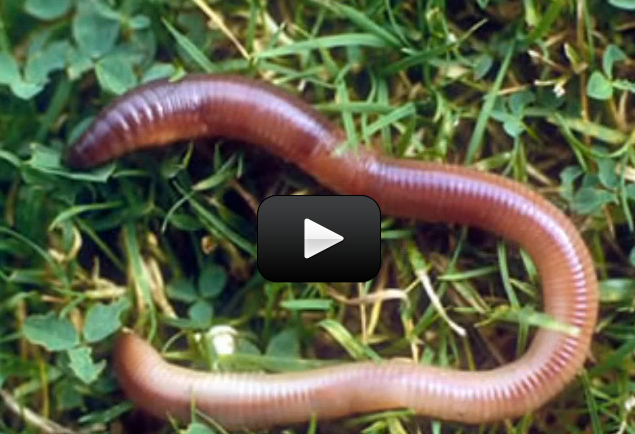Here we’re going to discuss the differences between three types of worms; flatworms, roundworms, and segmented worms. The word “worm” is not, in fact, a scientific name. It’s an informal way of classifying animals with long bodies and no appendages (no including snakes). They are bilaterally symmetrical (the right and left sides mirror each other). Worms live in salt and fresh water, on land, and inside other organisms as parasites.
The differences between the three types of worms we will discuss depend on the possession of a body cavity and segments. Flatworms have neither a body cavity nor segments. Roundworms only have a body cavity, and segmented worms have both a body cavity and segments.
Flatworms (Phylum Platyhelminthes) have incomplete digestive systems. That means that their digestive system has only one opening. The gas exchange occurs on the surface of their bodies. There are no blood vessels or nervous systems in flatworms. Some are non-parasitic, like the Sea flat worm, and some are parasitic, like the tapeworm.


Worms breathe through their skin, but this process only works if their skins stays moist.
Why do worms need miost things?
You can learn about worm reproduction here: https://unclejimswormfarm.com/composting-worm-reproduction-how-worms-reproduce/
I purchase his worms for my garden, and they are so much fun to take care of in a worm farm!
How do worms reproduce?
Could you really feed your worms mashed patatoes?
It depends on what kind of worms you have in your garden. Red wigglers (or manure worms) worm the best for composting projects. European night crawlers are also good, but not all species of worms will do well. They should be surface dwelling worms within the top 12 inches of soil, swarm their food, reproduce quickly, and survive well in captivity.
Can we use regular garden worms for this worm column?
so cooooooooooooooooooooooooooooooooooooooooooole
Yes I do!
https://www.sciencelearningspace2.com/2011/10/terraqua-column-how-does-water-affect-land-and-animals/
https://www.sciencelearningspace2.com/2011/10/predator-prey-who-eats-whom/
hi this is melody do you hove a episode on making fruit fly traps
I like the worm home it is so cool where do you live we don’t have red worms
so cool
That Is So AAAWWWEEESSSOOOMMMEEE!!!!!!!!!!!!!!!!!!!!!!!!!!!!!!!!!!!!!!!!!!!!!!!!!!!!!!!!!!!!!!!!!!!!!!!!!!!!!!!!!!!!!!!!!!!!!!!!!!!!!!!!!!!!!!!!!!!!!!!!!!!!!!!!!!!!!!!!!!!!!!!!!!!!!!!!!!!!!!!!!!!!!!!!!!!!!!!!!!!!!!!!!!!!!!!!!!!!!!!!!!!!!!!!!!!!!!!!!!!!!!!!!!!!!!!!!!!!!!!!!!!!!!!!!!!!!!!!!!!!!!!!!!!!!!!!!!!!!!!!!!!!!!!!!!!!!!!!!!!!!!!!!!!!!!!!!!!!!!!!!!!!!!!!!!!!!!!!!!:)!!!
Maybe I am just missing it, but where do I find the instructions for the earthworm dissection? The video is nice to show us what everything is, but we don’t know how to get to that part.
It’s the grossest thing ever! eeeeeeeeeeeeeeeeeeeeeeeeeeeeeeeeeeeeeeeeeeeeeeeeewwwwwwwwwwwwwwwwwwwwwwwwwwwwwwwwwwwwwwwwwwwwwwwwwwwwwwwwwwwwww!
-Olivia
COOL!!!!!!!!!!!!!!!!!!!!!!!!!!!!!!!!!!!!!!! Wow!!!! That is, SOOOOOOOOOOOOOOOOOOOOOOOOOOOOOOOOOOOOOOOOOOOOOOOOOOOOOOOOOOOOOOOOOOOOOOOOOOOOOOOOOOOOOOOOOOOOOOOOOOOOOOOOOOOOOOOOOOOOOOOOOOOOOOOOOOOOOOO,Cool!!!!!!!!!!!!
Wow! I never new there was so much to worms!
Tamar
Hmm… I wonder which part of the world you’re in, and what the climate is like. Do you normally have fruit flies around rotting food? You can (awful as this sounds) grab a sample from places they normally inhabit, and use this to start your own colony. Check places that normally attract these critters, like orchards where fruit has fallen off tress and is rotting on the ground. Hope this helps!
Hi, this is Batsheva,
I tried making a fruit fly trap but didn’t get any fruit flies.
I was very disappointed, I followed all of the steps and got a great trap.
I just didn’t get any flies.
What should I do?